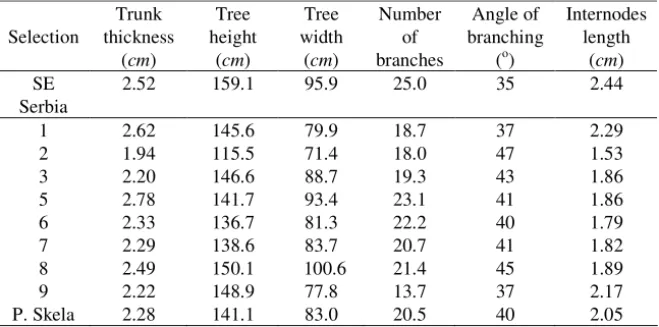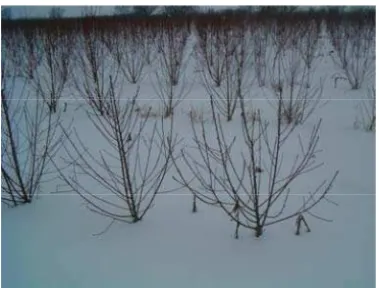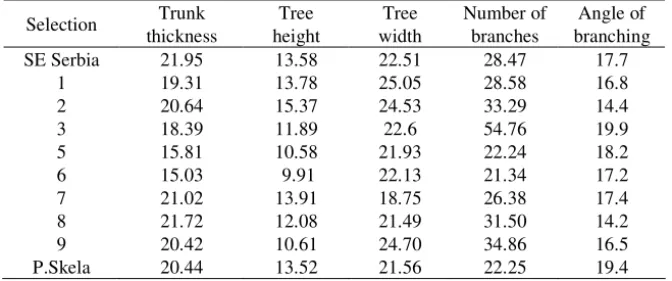______________________________
Corresponding author: Gordan Zec, Institut PKB Agroekonomik, Industrijsko naselje b.b., 11213 Padinska Skela, Srbija tel: 011 8871 175, e-mail: zec2004@yahoo.com
UDC 575: 634.25
Original scientific paper
VARIABILITY OF VINEYARD PEACH TREE CHARACTERISTICS
Gordan ZEC1, Slavica OLI 1, Dejan MARINKOVI 1 and Dragan NIKOLI 2
1Institute PKB Agroekonomik, Padinska Skela, Serbia 2Faculty of Agriculture, Zemun, Serbia
Zec G, S. oli , D. Marinkovic and D.Nikolic (2008):
Variability of vineyard peach tree characteristics.– Genetika, Vol. 40,
No. 1, 1-7.
have the lowest coefficients of variation for trunk thickness, tree height and number of branches, which points to the self-pollination as a good method for getting more uniform progeny.
Key words: vineyard peach, tree, characteristic, variability
INTRODUCTION
In Serbia Vineyard peach population is presented with a great number of native genotypes of peach (Prunus persica (L.)Batsch.) that have been cultivated
or spontaneously grown in nature. Autochthon populations of vineyard peach are rich source of genetic variability. That can contribute to an improvement of the most economically important characteristics of the contemporary growing peach cultivars and rootstocks for peach. SCORCAet al. (1985) emphasize that a genetic
variability of the most important cultivars is limited, so continuity in examinations and collections of the vineyard peach genotypes for gene banks is necessary. IEZZONI et al. (1991) said that richness of Prunus germplasm in Europe is an
important source that can ensure success in peach breeding.
Vineyard peach seedlings are the most important rootstock in our country (MIŠI et al., 1988).
LAYNEet al. (1976) believe that some characteristics of the grafted peach
cultivars such as vigor, ageing, ramification angle and cropping significantly depend on a rootstock influence. LAYNE (1987) also emphasizes that genetic variability and lack of uniformity in nursery and orchard are the main problems when it comes to usage of the vineyard peach seedlings as a peach rootstock. VUJANI -VARGAet al. (1990) single out selection of vineyard peach that gives less
vigor seedlings and 30% shorter fruit trees than the trees on unselected peach seedlings. MIŠI (2002) emphasize that medium vigor is one of the breeding goals
for peach rootstock.
Research of izoenzymatic systems of the 33 peach cultivars and 79 vineyard peach selections (GAŠI and OGNJANOV, 2000) showed higher genetic variability then established up to now.
Vineyard peach seeds, developed from open pollination of a great number of genotypes, are used in Serbian contemporary nursery production. The result is uniformity of the rootstocks for fruit trees.
The goal of this research was an evaluation and selection of the peach genotypes that would give uniform and less vigor progeny. The seedlings of these selections can be used as rootstocks for standard and high-density peach orchards.
MATERIALS AND METHODS
To design experimental-production peach and nectarine high-density orchard (one ha), the rootstocks were planted in the trial field in Padinska Skela in
beginning of June, on distance 3.5x1.0 m. In the beginning of the spring 2005, the
seedlings were cut down, and grafted at the place in the beginning of September. Data was collected during 2004 and 2005.
The groups of seedlings, derived from self (6, 7 and 8) and open-pollination (1, 2, 3, 5 and 9) of selected vineyard peach genotypes were used as a research material. As the references were taken two groups of peach seedlings (Padinska Skela and Southeast Serbia) derived from uncontrolled pollination of a great number of genotypes, with different geographical origin. This paper presents the results of research of morphological traits of more than 500 vineyard seedlings. The basic biometric indicators (average, coefficient of variance) were calculated according to HADŽIVUKOVI (1991) for all examined traits.
RESULTS AND DISCUSSION
Table 1 shows the average values of morphological traits of the researched seedlings. The lowest trunk thickness (1.94cm), tree height (115.5cm)
and width (71.4cm), as well as the most favorable branching angle (47o, picture 1)
and lowest internodes length (1.53cm) are the characteristics of the seedlings of the selection 2.
Table 1. Average values of morphological traits of examined vineyard peach seedlings (2004- 2005)
Selection
Trunk thickness
(cm)
Tree height
(cm)
Tree width (cm)
Number of branches
Angle of branching
(o)
Internodes length
(cm) SE
Serbia
2.52 159.1 95.9 25.0 35 2.44
1 2.62 145.6 79.9 18.7 37 2.29
2 1.94 115.5 71.4 18.0 47 1.53
3 2.20 146.6 88.7 19.3 43 1.86
5 2.78 141.7 93.4 23.1 41 1.86
6 2.33 136.7 81.3 22.2 40 1.79
7 2.29 138.6 83.7 20.7 41 1.82
8 2.49 150.1 100.6 21.4 45 1.89
9 2.22 148.9 77.8 13.7 37 2.17
Picture 1. Progeny (seedlings) of selection 2.
The lowest numbers of branches (13.7) have seedlings of the selection 9. Seedlings of Southeast group have the highest height (159.1cm), number of
branches (25), lowest branching angle (35o, picture 2) and the highest internodes length (2.44cm). The highest trunks thicknesses (2.78 cm) have seedlings of group 5, and the highest trees widths (100.6cm) have seedlings of group 8.
Picture 2. Seedling of South-East Serbia group
height ranged from 9.91 (sel. 6) to 15.37 (sel. 2). Examined material has higher uniformity than seedlings derived from open-pollination and that were examined by MILUTINOVI et al. (2000) who found the coefficient of variation for tree height
ranging from 15 to 30 for 90% of genotypes. According to ZEC (1997) coefficient of variation for tree height of a different vineyard peach selection (from open - pollination) ranged from 15 to 22.
Table 2.Coefficients of variation (Cv) of morphological traits of examined
vineyard peachseedlings (2004- 2005)
Selection Trunk thickness
Tree height
Tree width
Number of branches
Angle of branching
SE Serbia 21.95 13.58 22.51 28.47 17.7
1 19.31 13.78 25.05 28.58 16.8
2 20.64 15.37 24.53 33.29 14.4
3 18.39 11.89 22.6 54.76 19.9
5 15.81 10.58 21.93 22.24 18.2
6 15.03 9.91 22.13 21.34 17.2
7 21.02 13.91 18.75 26.38 17.4
8 21.72 12.08 21.49 31.50 14.2
9 20.42 10.61 24.70 34.86 16.5
P.Skela 20.44 13.52 21.56 22.25 19.4
Progeny of the selection 6, derived from self-pollination, has the lowest coefficients of variation for trunk thickness, tree height and number of branches.
The lowest coefficient of variation for tree width has progeny of the selection 7, while progeny of the selection 8 has the lowest coefficient of variation for branching angle.
The highest coefficients of variation were calculated for trunk thickness of the SE Serbia progeny (21.9), for tree height of the selection 2 progeny (15.4), for tree width of the selection 1 progeny (25). Progeny of the selection 3 has the highest coefficient of variation for number of branches (54.8) and branching angle (19.9).
CONCLUSION
The examined progenies of some vineyard peach selections, whether they derived from self or open pollination of few genotypes, or from uncontrolled pollination of many genotypes, showed a great morphological variability and inequality.
Seedlings of the selection 6 have the lowest coefficients of variation for trunk thickness, tree height and number of branches. That shows self-pollination can be a good method for getting more uniform progeny. Chosen seedlings, originated from the selections 2 and 6 will be basic material for further inbreeding in the aim for getting quality and more uniform generative progeny.
Received November 25th, 2007 Accepted February 28th, 2008
REFERENCES
GAŠI , K.and V. OGNJANOV (2000): Izoenzimska varijabilnost u germplazmi breskve. Uvodni referat i abstrakti 11. kongresa vo ara Jugoslavije, 21.-25.11.2000., Tara, 24.
HADŽIVUKOVI , S. (1991): Statisti ki metodi sa primenom u poljoprivrednim i biološkim istraživanjima. Institut za ekonomiku poljoprivrede i sociologiju sela, Novi Sad.
IEZZONI, A., H. SCHMIDT and A. ALBERTIN (1991): Genetic resources of temperate fruit and nut crops. 1. Inter. Con. for. HortSci., Wageningen.
LAYNE, R.E.C., G.M. WEAVER, H.O. JACKSON and F.D. STROUD (1976): Influence of peach seedling rootstocks on growth, yield and survival of peach scion cultivars. J. Amer. Soc. Hort. Sci.
101, 5: 568-572.
LAYNE, R.E.C. (1987): Peach rootstocks. In: Rootstock for fruit crops, 185-216, ed. by Rom, R.C. and Carlson, R.F., A. WILEY-INTERSCIENCE PUBLICATION, Canada.
MILUTINOVI , D.M., D .NIKOLI , V.RAKONJAC and M.FOTIRI (2000): Klijavost semena i porast sejanaca genotipova vinogradske breskve. Jugoslovensko vo arstvo, 34, 129-130: 69-74.
MIŠI , P.D., V. PAVLOVI , R. TODOROVI , M. MIRKOVI (1988): Selekcija vinogradske breskve kao podloge za breskvu. Jugoslovensko vo arstvo, 84-85: 135-141.
MIŠI, P.D. (2002): Oplemenjivanje breskve. U: Specijalno oplemenjivanje vo aka. Partenon, Beograd, 145-176.
SCORZA, W., S.MEHLENBACHER and G.ZIGHTER (1985): Inbreeding and coancenstry of freestone peach cultivars of the Eastern United States and implication for peach gerplasm improvement. Journal of the American Society for Horticultural science, 110: 547-552.
ZEC, G. (1997): Prou avanje odabranih genotipova iz populacije vinogradske breskve. Magistarska teza. Univerzitet u Beogradu. 18-23.
VARIJABILNOST OSOBINA STABLA SEJANACA VINOGRADSKE BRESKVE
Gordan ZEC 1, Slavica OLI 1, Dejan MARINKOVI 1 i Dragan NIKOLI 2
1 Institut PKB Agroekonomik, Padinska Skela 2
Poljoprivredni fakultet, Zemun, Srbija
I z v o d
Sejanci vinogradske breskve su najvažnija podloga za breskvu u našoj zemlji i šire. Sadni materijal vinogradske breskve koji se koristi u rasadni arstvu kao podloga, karakteriše velika neujedna enost. Višegodišnjim radom su odabrani i kolekcionisani genotipovi sa kvalitetnim svojstvima. Ispitivanja su obavljena na sejancima koji predstavljaju potomstva devet odabranih genotipova, nastala samooplodnjom i slobodnom oplodnjom. Standard su predstavljali sejanci koji su nastali nekontrolisanom oplodnjom ve eg broja genotipova, razli itog geografskog porekla. Cilj rada je dobijanje genotipova vinogradske breskve koji e davati ujedna eno generativno potomstvo sa kvalitetnim osobinama. U radu su prikazani dvogodišnji rezultati ispitivanja morfoloških osobina stabla preko 500 sejanaca vinogradske breskve. Na osnovu dobijenih rezultata izdvojeni su pozitivni genotipovi za dalji inbriding. Najmanji koeficijenti varijacije kod sejanaca selekcije 6 za debljinu debla, visinu stabla i broj grana ukazuju da se samooplodnjom može dobiti potomstvo ve e ujedna enosti.
Primljeno 25. XI 2007.


